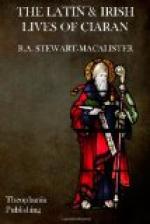Findian of Cluain Iraird (Clonard, Co.
Meath), 12 December 548.
Findian of Mag-bile (Moville, Co.
Donegal), 12 September 579.
Colum Cille of I Choluim Cille (Iona),
9 June 592.
Colum of Inis Cealtra (Holy Island, Loch
Derg), 13 December 549.
Ciaran of Cluain maccu Nois (Clonmacnois),
9 September 548.
Cainnech of Achad Bo (Aghaboe, Queen’s
Co.), 11 October 598.
Comgall of Beannchor (Bangor, Co.
Down), 10 May 552.
Brenainn of Birra (Birr, King’s
Co.), 29 November 571.
Brenainn of Cluain Fearta (Clonfert, King’s
Co.), 16 May 576.
Ruadan of Lothra (Lorrha, Co. Tipperary),
15 April 584.
Ninned of Inis Muighe Saimh (Inismacsaint
in Loch Erne),
18
January 5..(?).
Mo-Bi of Glas Naoidhean (Glasnevin, Co.
Dublin) 12 October 544.
Mo-Laise mac Nad-Fraeich of Daimhinis
(Devenish, Loch Erne),
12
September 563.
XIX. CIARAN AND THE KING’S DAUGHTER (LA, VG)
Parallels.—Maignenn never would look on a woman, “lest he should see her guardian devil” (Silua Gadelica, i, 37). The story has some affinity with the curious Maerchen of the Mill and the Bailiff’s Daughter (incident XXIV). Cuimmin of Connor, in his poem on the characters of the different Irish saints, spoke thus of Ciaran, doubtless in reference to this incident: “Holy Ciaran of Clonmacnois loved humility that he did not abandon rashly; he never spoke a word that was untrue, he never looked at a woman from the time when he was born.”
The Stanza in VG.—Metre ae freslige. Literally thus: “With Ciaran read / a girl who was stately with treasures // and he saw not / her form or her shape or her make.”
In LA the father of the maiden is king in Tara: in VG he is king of Cualu, the strip of territory between the mountains and the sea from Dublin southward to Arklow.
XX. HOW CIARAN HEALED THE LEPERS (VG)
Leprosy, or at least a severe cutaneous disease so called, was common in ancient Ireland; and there are numerous stories, some of them extremely disagreeable, that tell how the saints associated with its victims as an act of self-abasement. We have already seen how Patrick was said to have kept a leper. Brigit also healed lepers by washing (LL, 1620), and Ruadan cleansed lepers with the water of a spring that he opened miraculously (VSH, ii, 249). Contrariwise, Munnu never washed except at Easter after contracting leprosy (VSH, ii, 237). The miraculous opening of a spring is a common incident in Irish hagiography; we have already seen an example, in the annotations to incident I.
Whitley Stokes points out (LL, note ad loc.) that the “three waves” poured over the lepers are suggested by the triple immersion in baptism.




